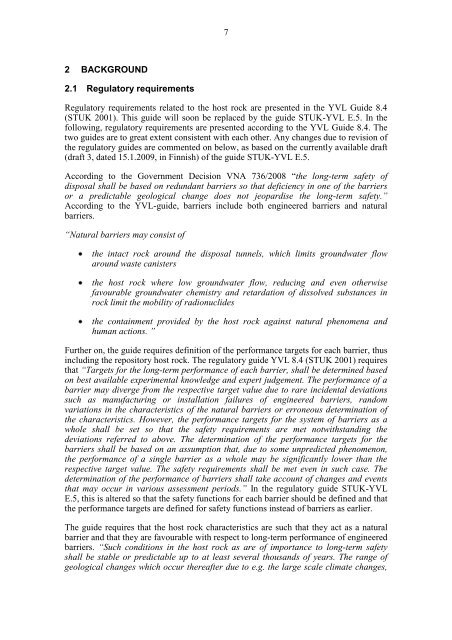RSC-Programme - Interim Report. Approach and Basis for - Posiva
RSC-Programme - Interim Report. Approach and Basis for - Posiva
RSC-Programme - Interim Report. Approach and Basis for - Posiva
Create successful ePaper yourself
Turn your PDF publications into a flip-book with our unique Google optimized e-Paper software.
72 BACKGROUND2.1 Regulatory requirementsRegulatory requirements related to the host rock are presented in the YVL Guide 8.4(STUK 2001). This guide will soon be replaced by the guide STUK-YVL E.5. In thefollowing, regulatory requirements are presented according to the YVL Guide 8.4. Thetwo guides are to great extent consistent with each other. Any changes due to revision ofthe regulatory guides are commented on below, as based on the currently available draft(draft 3, dated 15.1.2009, in Finnish) of the guide STUK-YVL E.5.According to the Government Decision VNA 736/2008 “the long-term safety ofdisposal shall be based on redundant barriers so that deficiency in one of the barriersor a predictable geological change does not jeopardise the long-term safety.”According to the YVL-guide, barriers include both engineered barriers <strong>and</strong> naturalbarriers.“Natural barriers may consist ofthe intact rock around the disposal tunnels, which limits groundwater flowaround waste canistersthe host rock where low groundwater flow, reducing <strong>and</strong> even otherwisefavourable groundwater chemistry <strong>and</strong> retardation of dissolved substances inrock limit the mobility of radionuclidesthe containment provided by the host rock against natural phenomena <strong>and</strong>human actions. ”Further on, the guide requires definition of the per<strong>for</strong>mance targets <strong>for</strong> each barrier, thusincluding the repository host rock. The regulatory guide YVL 8.4 (STUK 2001) requiresthat “Targets <strong>for</strong> the long-term per<strong>for</strong>mance of each barrier, shall be determined basedon best available experimental knowledge <strong>and</strong> expert judgement. The per<strong>for</strong>mance of abarrier may diverge from the respective target value due to rare incidental deviationssuch as manufacturing or installation failures of engineered barriers, r<strong>and</strong>omvariations in the characteristics of the natural barriers or erroneous determination ofthe characteristics. However, the per<strong>for</strong>mance targets <strong>for</strong> the system of barriers as awhole shall be set so that the safety requirements are met notwithst<strong>and</strong>ing thedeviations referred to above. The determination of the per<strong>for</strong>mance targets <strong>for</strong> thebarriers shall be based on an assumption that, due to some unpredicted phenomenon,the per<strong>for</strong>mance of a single barrier as a whole may be significantly lower than therespective target value. The safety requirements shall be met even in such case. Thedetermination of the per<strong>for</strong>mance of barriers shall take account of changes <strong>and</strong> eventsthat may occur in various assessment periods.” In the regulatory guide STUK-YVLE.5, this is altered so that the safety functions <strong>for</strong> each barrier should be defined <strong>and</strong> thatthe per<strong>for</strong>mance targets are defined <strong>for</strong> safety functions instead of barriers as earlier.The guide requires that the host rock characteristics are such that they act as a naturalbarrier <strong>and</strong> that they are favourable with respect to long-term per<strong>for</strong>mance of engineeredbarriers. “Such conditions in the host rock as are of importance to long-term safetyshall be stable or predictable up to at least several thous<strong>and</strong>s of years. The range ofgeological changes which occur thereafter due to e.g. the large scale climate changes,
















